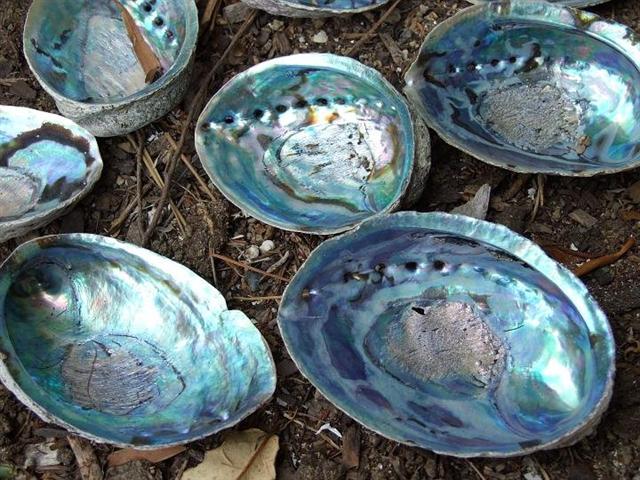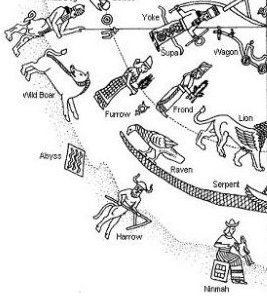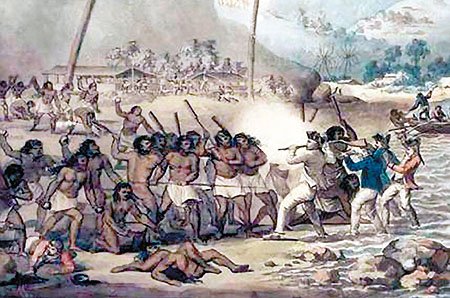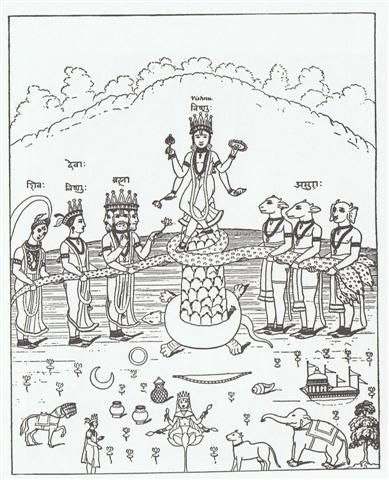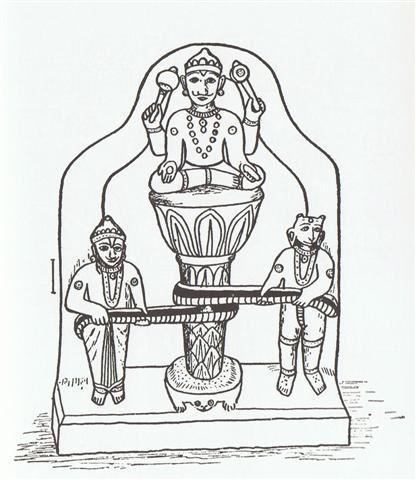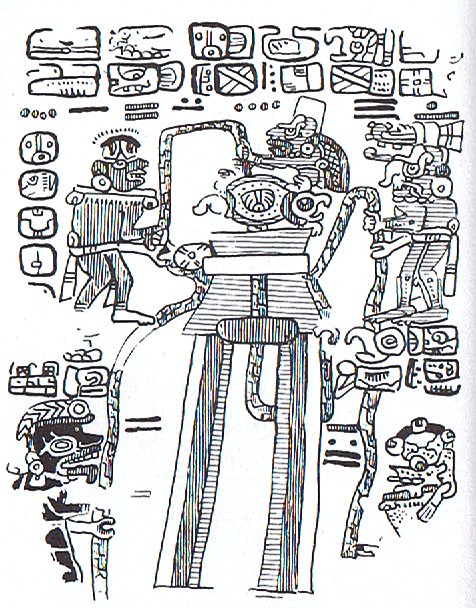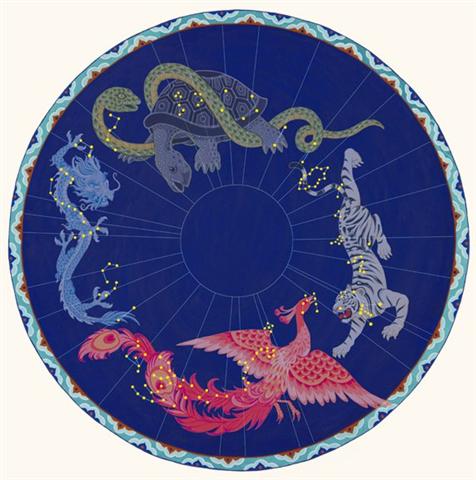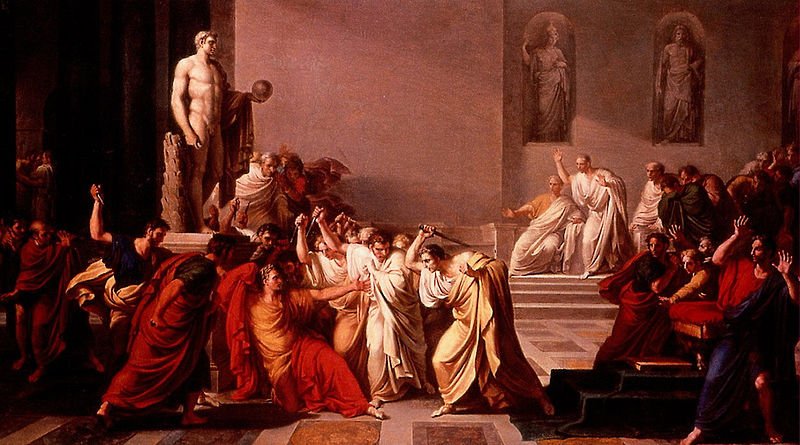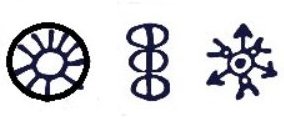51. We are now ready to begin to discuss the only pair of triplet maitaki in the C text:
Counting from tagata honui in Ca1-6 up to and including ku honui in Ca9-17 (245) there were 240 glyphs.
At the time of Hyadum II the 'Egg' (Beid, ο Eridani) was still inside (not yet visible), but 3 days later the 'Eye' (Ain, ε Tauri) emerged. ... A very detailed myth comes from the island of Nauru. In the beginning there was nothing but the sea, and above soared the Old-Spider. One day the Old-Spider found a giant clam, took it up, and tried to find if this object had any opening, but could find none.
She tapped on it, and as it sounded hollow, she decided it was empty. By repeating a charm, she opened the two shells and slipped inside. She could see nothing, because the sun and the moon did not then exist; and then, she could not stand up because there was not enough room in the shellfish. Constantly hunting about she at last found a snail. To endow it with power she placed it under her arm, lay down and slept for three days. Then she let it free, and still hunting about she found another snail bigger than the first one, and treated it in the same way. Then she said to the first snail: 'Can you open this room a little, so that we can sit down?' The snail said it could, and opened the shell a little. Old-Spider then took the snail, placed it in the west of the shell, and made it into the moon. Then there was a little light, which allowed Old-Spider to see a big worm. At her request he opened the shell a little wider, and from the body of the worm flowed a salted sweat which collected in the lower half-shell and became the sea. Then he raised the upper half-shell very high, and it became the sky. Rigi, the worm, exhausted by this great effort, then died. Old-Spider then made the sun from the second snail, and placed it beside the lower half-shell, which became the earth ... The junction between the bivalve shells of the 'giant clam' (or 'turtle') ought to have corresponded to the upper and lower hemispheres of the sky or of the year.
... After the great flood had at long last receded, Raven had gorged himself on the delicacies left by the receding water, so for once, perhaps the first time in his life, he wasn't hungry. But his other appetites, his curiosity and the unquenchable itch to meddle and provoke things, to play tricks on the world and its creatures, these remained unsatisfied. Raven gazed up and down the beach. It was pretty, but lifeless. There was no one about to upset, or play tricks upon. Raven sighed. He crossed his wings behind him and strutted up and down the sand, his shiny head cocked, his sharp eyes and ears alert for any unusual sight or sound. The mountains and the sea, the sky now ablaze with the sun by day and the moon and stars he had placed there, it was all pretty, but lifeless. Finally Raven cried out to the empty sky with a loud exasperated cry. And before the echoes of his cry faded from the shore, he heard a muffled squeak. He looked up and down the beach for its source and saw nothing. He strutted back and and forth, once, twice, three times and still saw nothing. Then he spied a flash of white in the sand. There, half buried in the sand was a giant clamshell. As his shadow fell upon it, he heard another muffled squeak. Peering down into the opening between the halves of the shell, he saw it was full of tiny creatures, cowering in fear at his shadow. Raven was delighted. Here was a break in the monotony of the day. But how was he to get the creatures to come out of their shell and play with him? Nothing would happen as long as they stayed inside the giant clamshell. They were not going to come out as long as they were so afraid of him. So Raven leaned over his head, close to the shell, and with all the cunning and skill of that smooth trickster's tongue, that had so often gotten him in and out of so many misadventures during his troubled and troublesome existence, he coaxed and cajoled and coerced the little creatures to come out and play in his wonderful shiny new world. As you know the Raven has two voices, one harsh and strident, and the other which he used now, a seductive, bell-like croon which seems to come from the depth of the sea, or out of the cave where winds are born. It is an irresistable sound, one of the loveliest in the world ... And the opening between these great turtle or clam shells (hemispheres) could for instance have measured 41 days from Cb7-11 up to and including Cb8-24. Maybe we should understand these glyph drawings as fully opened bivalves?
7 * 11 = 77 and 8 * 24 = 192 and 192 - 77 = 115 - as in "April 25 (Vaitu Nui 25 when the Explorers left their old homeland). The glyphs above seem to illustrate the stars which were rising heliacally. But Spica - Ana-roto - she was close to the Full Moon, she was at the other side:
... 'My child', said Makea now in a tone of deep sorrow, 'there has been a bad omen for us. When I performed the tohi [cfr Tohil who had the Fire] ceremony over you I missed out a part of the prayers. 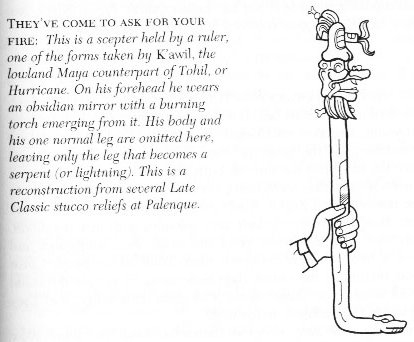 I remembered it too late. I am afraid this means that you are going to die.' 'What's she like, Hine nui te Po?' asked Maui. 'Look over there', said Makea, pointing to the ice-cold mountains beneath the flaming clouds of sunset. 'What you see there is Hine nui, flashing where the sky meets the earth. Her body is like a woman's, but the pupils of her eyes are greenstone and her hair is kelp. Her mouth is that of a barracuda, and in the place where men enter her she has sharp teeth of obsidian and greenstone' ...
... A vestige of the practice of putting the king to death at the end of a year's reign appears to have survived in the festival called Macahity, which used to be celebrated in Hawaii during the last month of the year. About a hundred years ago a Russian voyager described the custom as follows: 'The taboo Macahity is not unlike to our festival of Christmas. It continues a whole month, during which the people amuse themselves with dances, plays, and sham-fights of every kind. The king must open this festival wherever he is. On this occasion his majesty dresses himself in his richest cloak and helmet, and is paddled in a canoe along the shore, followed sometimes by many of his subjects. He embarks early, and must finish his excursion at sunrise. The strongest and most expert of the warriors is chosen to receive him on his landing. The warrior watches the canoe along the beach; and as soon as the king lands, and has thrown off his cloak, he darts his spear at him, from a distance of about thirty paces, and the king must either catch the spear in his hand, or suffer from it: there is no jesting in the business. Having caught it, he carries it under his arm, with the sharp end downwards, into the temple or heavoo. On his entrance, the assembled multitude begin their sham-fights, and immediately the air is obscured by clouds of spears, made for the occasion with blunted ends. Hamamea (the king) has been frequently advised to abolish this ridiculous ceremony, in which he risks his life every year; but to no effect. His answer always is, that he is as able to catch a spear as any one on the island is to throw it at him. During the Macahity, all punishments are remitted throughout the country; and no person can leave the place in which he commences these holidays, let the affair be ever so important ...
... Sacred product of the people's agriculture, the installation kava is brought forth in Lau by a representative of the native owners (mataqali Taqalevu), who proceeds to separate the main root in no ordinary way but by the violent thrusts of a sharp implement (probably, in the old time, a spear) ... The Babylonians placed the symbol of Saturn a quarter after Jupiter - i.e. in fall:
Daylight would then gradually return after the winter solstice. ... Cook's first visit, to Kaua'i Island in January 1778, fell within the traditional months of the New Year rite (Makahiki). He returned to the Islands late in the same year, very near the recommencement of the Makahiki ceremonies. Arriving now off northern Maui, Cook proceeded to make a grand circumnavigation of Hawai'i Island in the prescribed clockwise direction of Lono's yearly procession, to land at the temple in Kealakekua Bay where Lono begins and ends his own circuit. The British captain took his leave in early February 1779, almost precisely on the day the Makahiki ceremonies closed. But on his way out to Kahiki, the Resolution sprung a mast, and Cook committed the ritual fault of returning unexpectedly and unintelligibly. The Great Navigator was now hors catégorie, a dangerous condition as Leach and Douglas have taught us, and within a few days he was really dead - though certain priests of Lono did afterward ask when he would come back ...
But if the Sun year had only 10 months, then the return of the Sun King could not be until January and February were in the past and light in the sky could really be observed to quickly increase. Therefore "March 1 at the 'underlined' vero in Cb8-6 should correspond to the proper time of the battle. The dot means a sharp point had been used to mark this glyph. 41 precessional days later than the time of Bharani this was in April, and Metoro here told Bishop Jaussen to count (hia). It was Julius Caesar who was responsible for the year with 12 months, and he was born in July (as in Julius). Counting 9 months' pregnancy from for instance 188 (July 7) we could arrive in day 188 + 273 - 365 = 96 (April 6). But at the time of Caesar - 27 precessional days earlier - the date would have been 96 - 27 = 69 ('March 8).
... The brutes of spring caused the downfall of both Captain Cook and Julius Caesar.
We are close to the key myth of mankind, that which explains the regeneration of sun and of growth. Once at least some people kept the tradition living. I became interested in what really happened at March 15 and reopened Henrikson to find out. Caesar was forewarned of the threat by the prophet Spurinna, who told him that a great threat was coming at Idus Martiae or just before. The day arrived and Caesar was still living, walking to his meeting with the Senate when he happened to encounter Spurinna and told him jokingly that he was still alive. Spurinna calmely answered that the day had yet not ended. The Romans divided their months in two parts and the dividing point was Idus, which in some way was connected with full moon. March 15 was the midpoint of March, which is close to spring equinox. The old agricultural year defined the beginning of the year to the time when sun returned, and it was connected with Mars ...
'March 14 could be understood as day 3-14 (similar to how the price tag 10 / 6 in the hat of Mercury meant 'June 10).
But for the Chinese it was simple - a new year began 5-6 days after the winter solstice and this had to come after the wooden clappers in early April: ... In China, every year about the beginning of April, certain officials called Sz'hüen used of old to go about the country armed with wooden clappers. Their business was to summon the people and command them to put out every fire. This was the beginning of the season called Han-shih-tsieh, or 'eating of cold food'. For three days all household fires remained extinct as a preparation for the solemn renewal of the fire, which took place on the fifth or sixth day after the winter solstice [Sic!]. The ceremony was performed with great pomp by the same officials who procured the new fire from heaven by reflecting the sun's rays either from a metal mirror or from a crystal on dry moss. Fire thus obtained is called by the Chinese heavenly fire and its use is enjoined in sacrifices: whereas fire elicited by the friction of wood is termed by them earthly fire, and its use is prescribed for cooking and other domestic purposes ... Measuring from Ain to Spica we will find 202 - 64 = 138 days. 3 * 138 = 414 (as in *41.4 for Bharani). There should be 3 legs for cooking pots.
|
||||||||||||||||||||||||||||||||||||||||||||||||||||||||||||||||||||||||||||||||||||||||||||||||||||||||||||||||||||||||||||||||||||||||||||||||||||||||||||||||||||||||||||||||||||||||||||||||||||||||||||||||||||||||||||||||||||||||||||||||||||||||||||||||||||||||||||||||||||||||||||||||||||||||||||||||||||||||||||||||||||||||||










